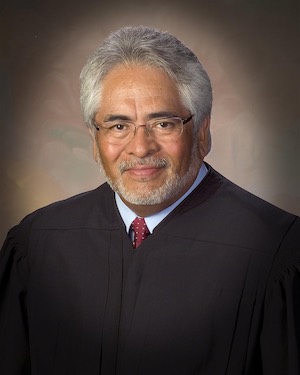“If the construction of a claim term is in dispute and the dispute is not addressed by the district court, the Federal Circuit may remand the case for further proceedings even if the challenged claims point strongly in the direction of ineligibility under 35 U.S.C. § 101.”

Judge Jimmie Reyna
The Federal Circuit recently vacated and remanded a decision by the Northern District of California granting a motion on the pleadings that claims related to “toolbars” on computers were ineligible under 35 U.S.C. § 101. The Court, holding that the district court failed to address a claim construction dispute, was “hesitant to construe patent claims in the first instance on appeal” and remanded for further proceedings. Judge Lourie authored a dissent, finding the claims to be “clearly abstract, regardless of claim construction,” and opined that he would have affirmed the district court’s holding. See MyMail, Ltd. v. ooVoo, LLC, Nos. 2018-1758, 2018-1759, 2019 U.S. App. LEXIS 24430 (Fed. Cir. Aug. 16, 2019) (Before Lourie, O’Malley, and Reyna, Circuit Judges) (Opinion for the Court, Reyna, Circuit Judge) (Dissenting opinion, Lourie, Circuit Judge).
The Toolbar Patents
MyMail, Ltd. (“MyMail”) is the assignee of U.S. Patent Nos. 8,275,863 (“the ’863 patent”) and 9,021,070 (“the ’070 patent”), which are both directed to toolbars that are displayed on computers. Claim 1 of the ’863 patent, which is representative of the claims for both patents, recites in part:
1. A method of modifying a toolbar, comprising the steps of:
a user Internet device displaying a toolbar comprising one or more buttons, the toolbar defined by toolbar data stored in one or more toolbar-defining databases, the toolbar data comprising a plurality of attributes, each attribute associated with a button of the toolbar, wherein for each button of the toolbar, at least one of the plurality of attributes identifying a function to be performed when the button is actuated by the user Internet device;
…
the user Internet device updating, by the operation, the toolbar data in accordance with the toolbar update data, thereby producing updated toolbar data, the updating comprising at least one of the following steps (a) and (b), each respectively comprising:
(a) writing at least one new attribute to the original toolbar data, wherein the writing at least one new attribute to the toolbar data comprises changing the one or more buttons of the toolbar by adding a button; and
(b) updating at least one attribute of the toolbar data; and the user Internet device displaying the toolbar as defined by the updated toolbar data.
Claim 1 of the ’070 patent recites similar features. In 2016, MyMail filed suit against ooVoo, LLC (“ooVoo”) and IAC Search & Media, Inc. (“IAC”) in the Eastern District of Texas for infringing the two patents. After the Supreme Court decided TC Heartland LLC v. Kraft Foods Group Brands LLC, 137 S. Ct. 1514 (2017), both cases were transferred to the Northern District of California. There, both defendants moved for judgment on the pleadings, asserting that the claims of both patents were ineligible under 35 U.S.C. § 101. MyMail argued that the court should adopt a claim construction for the term “toolbar” from a previous case in the Eastern District of Texas regarding the ’070 patent. The district court, however, did not adopt the claim construction nor did it construe the term at all.
Abstract Under Alice
Instead, the district court held that the claims for both patents were patent ineligible using the two-part framework in Alice Corp. v. CLS Bank Int’l, 573 U.S. 208 (2014). At step 1, the district court found the claims to be “directed to a process for updating toolbar software over a network without user intervention,” which it considered to “fall within the category of gathering and processing information” that is directed to an abstract idea. At step 2, the district court held the claims did not provide an inventive concept as the “Internet-connected computers and servers” recited in the claims were “already in widespread use” and are routine and conventional. To that end, the district court held the claims were ineligible under Section 101, and MyMail appealed.
The Court first described the Ninth Circuit standard for a Rule 12(c) motion, stating that “[p]atent eligibility may be determined on a Rule 12(c) motion, but only when there are no factual allegations that, if taken as true, prevent resolving the eligibility question as a matter of law.” (Quoting Aatrix Software, Inc. v. Green Shades Software, Inc., 882 F.3d 1121, 1125 (Fed. Cir. 2018).) Because “eligibility requires a full understanding of the basic character of the claimed subject matter,” “if the parties raise a claim construction dispute at the Rule 12(c) stage, the district court must either adopt the non-moving party’s constructions or resolve the dispute to whatever extent is needed to conduct the § 101 analysis.”
Error Under Aatrix
In the previous Eastern District of Texas case, the district court construed “toolbar” to describe a “button bar that can be dynamically changed or updated via a pinger process or a MOT script.” MyMail argued that this construction “confirms that the claims of the ’070 patent are directed to a particular technological process for improving an exclusively computer-oriented device.” The Northern District of California, however, did not adopt the construction of “toolbar” nor did it decide on any other construction of the term. On appeal, the defendants argued that this error could be dismissed because the remainder of the elements clearly show that the claims were ineligible.
The Court disagreed and held that the Northern District of California’s “failure to address the parties’ claim construction dispute is error under Aatrix.” See id. at 1125. Because the Court is “generally hesitant to construe patent claims in the first instance on appeal,” the court vacated and remanded for further proceedings.
Lourie Weighs In
In his dissent, Judge Lourie took the position that “the claims at issue are clearly abstract, regardless of claim construction,” and opined that the Court should affirm. Citing Elec. Power Group, LLC v. Alstom S.A., 830 F.3d 1350 (Fed. Cir. 2016), Judge Lourie described how “analysis, transmission, and display of information are, in themselves, abstract ideas.” Because the computers in MyMail’s patents were “off-the-shelf” computers that gathered, sent, and displayed information, the claims are ineligible. He also noted that no “inventive programming” was disclosed in the patents.
As for the “pinger process” and “MOT script” in the Eastern District of Texas’s construction, Judge Lourie stated that these features could not provide the inventive concept necessary to save the claims. MyMail’s appeal brief disclosed how the pinger process consists of programming an off-the-shelf computer to send data. Judge Lourie concluded by asserting that he would not have remanded the case.

![[IPWatchdog Logo]](https://ipwatchdog.com/wp-content/themes/IPWatchdog%20-%202023/assets/images/temp/logo-small@2x.png)



![[Advertisement]](https://ipwatchdog.com/wp-content/uploads/2024/04/Patent-Litigation-Masters-2024-sidebar-early-bird-ends-Apr-21-last-chance-700x500-1.jpg)

![[Advertisement]](https://ipwatchdog.com/wp-content/uploads/2021/12/WEBINAR-336-x-280-px.png)
![[Advertisement]](https://ipwatchdog.com/wp-content/uploads/2021/12/2021-Patent-Practice-on-Demand-recorded-Feb-2021-336-x-280.jpg)
![[Advertisement]](https://ipwatchdog.com/wp-content/uploads/2021/12/Ad-4-The-Invent-Patent-System™.png)







Join the Discussion
3 comments so far.
Night Writer
September 4, 2019 08:32 amThe one thing you can be sure of is with Reyna that anything he writes is going to be devoid of connection with reality. He admitted that he knew nothing of science or patent law when Obama appointed him based on a recommendation from SV.
concerned
September 3, 2019 09:51 am“Because the computers in MyMail’s patents were “off-the-shelf” computers that gathered, sent, and displayed information, the claims are ineligible. He also noted that no “inventive programming” was disclosed in the patents.”
I suspect I will get this kind of dance in my appeal. Even though the “dedicated” computer network of the administrating agency could not solve the problem for decades, somehow my little ole alleged “generic” computer just analyzes and displays data to solve the problem.
Of course, said data that I will have will be less than the administrating agency’s world class data, yet there was allegedly no inventive step that solved the problem.
I anticipate a rejection that will be illogical and not address how inferior computers and inferior data somehow magically solved a problem that experts could not with better tools and better data. Of course there are inventive steps.
As Mr. Quinn would aptly state “Spewing Illogical Nonsense Does Not Make It True” yet inventors live with this reality every day.
Curious
September 3, 2019 08:09 amJudge Lourie described how “analysis, transmission, and display of information are, in themselves, abstract ideas.”
I recommend that Judge Lourie actually read Electric Power Group. It was far more nuanced than Lourie’s characterization. I also recommend that Judge Lourie review Alice Corp and notice the passages that state “At the same time, we tread carefully in construing this exclusionary principle lest it swallow all of patent law … At some level, ‘all inventions . . . embody, use, reflect, rest upon, or apply laws of nature, natural phenomena, or abstract ideas.'” Core Wireless also holds that an improved user interface is not an abstract idea.